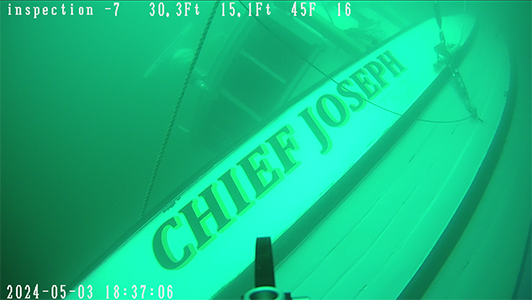||| BY MATTHEW GILBERT, theORCASONIAN OP-ED REPORTER |||
More than 100 people showed up – most of them virtually, though the meeting room was full – at the May 17, 2022 meeting of the San Juan County Council, drawn by the heat surrounding two public hearings:
- To Consider adopting an Ordinance Establishing a Cap on Permits for Vacation Rental of Residences or Accessory Dwelling Units (ADUs) not to Exceed 1,200 Permits Countywide; Amending SJCC 18.40.275
- To Consider Removal of a Planning Commissioner Pursuant to RCW 36.70.110
The second hearing was quickly cancelled after a motion by Jamie Stephens, who felt there was little evidence or background. He was joined by Christine Minney and Cindy Wolf, who had made the original motion for the hearing.
And despite again being beset by technical difficulties, the first hearing went on more or less as scheduled as the end (July 13) of the moratorium on Vacation Rental (VR) permits loomed.
DCD planner Sophia Cassam got things rolling with a presentation that briefly summarized the history of this marathon debate, noting that caps “at or below current numbers will halt acceptance of new VR permit applications . . . until enough existing permits are abandoned, expire, or revoked due to noncompliance.”
Over 60 people weighed in during a comment period that stretched toward three hours, reflecting most of what has already been said over the previous two years of discussion and hearings. Callers from San Juan again took up most of the airtime, and a couple of new-ish observations did stand out:
- Those against caps – overwhelmingly from San Juan Island – often described those in favor of caps as being “anti-tourism” and out to sabotage the local economy.
- Frequent allegations of “insufficient data” to support a cap lead to claims of insufficient data on the harm of a cap. There is data on both sides, though incomplete.
- Most recently, research into the County database by Lopez residents Chom and Chris Greacen found that 57% of vacation rentals countywide (82% on Lopez) have non-resident ownership (though not necessarily corporate), and more than half of all VR property sales on Lopez in the last two years were to corporations.
- A member of the local ferry advisory committee wondered why you would want more people coming to the islands (more lodging correlates to more traffic) when the system is essentially breaking down and no new capacity can be expected for another 20 years.
Council Discussion
There were four options on the table for setting the number of VR caps:
- Active and compliant as of July 31, 2021 – 413
- Compliant as of July 31 – 650
- Originally “floated” by Council – 1,200
- Compliant at the date the ordinance is adopted – 731 (as of May 6)
There are currently around 200 non-compliant permit holders. DCD Director David Williams expects that about 70% of them will likely become compliant following another six months of ongoing enforcement efforts.
Jamie Stephens began the discussion by saying he supported a concrete cap number (as opposed to one based on a percentage of total residential units) and proposed a five-year review – though it was then pointed out that the Council can review and change these numbers at any time. Christine Minney agreed to a concrete cap but suggested going “beyond the existing four options” to accommodate each island’s needs.
Wolf then proposed a cap of 211 on Orcas, reflecting enduring community sentiment for setting the cap at “Active and compliant” as first proposed by the Planning Commission in July 2021 prior to its turnover in commissioners and long advocated by the Vacation Rental Work Group. [Note: Wolf had added five new “findings” to the proposed ordinance that described the history of meetings and public sentiment behind the push for caps, most notably on Orcas.]
Stephens, citing testimony that VR owners need and use their rentals for a variety of reasons “not just as a money grab [but] so they can keep living here, so they can keep a house in their family,” chose 135 for Lopez to provide room for growth – a 10% increase over current permit holders both compliant and noncompliant.
Minney, acknowledging that the impacts of VRs are not felt to the same degree on San Juan as on Orcas, chose 337 as the cap: the current number of all permits both compliant and not as of May 6.
And so, in the end, the Council opted for a compromise number of countywide caps between Options 1 and 3 that also respected the zeitgeist of each island:
- San Juan: 337 (There are currently 136 active and compliant permits, 93 that are compliant but inactive, and 71 that are noncompliant)
- Orcas: 211 (207 compliant-active / 159 compliant-inactive / 90 noncompliant)
- Lopez: 135 (56 compliant-active / 38 compliant-inactive / 27 noncompliant)
- Outer Islands: 10 (2 / 7)
- TOTAL 693
Final language, along with updated findings supporting these numbers, will be summarized in a new ordinance. Available permits for each island will be chosen by lottery at the beginning of each calendar year.
It should also be noted that compliant but inactive permit holders can activate at any time. So, in the case of Orcas, there could, hypothetically, be as many as 366 active rental units in addition to however many noncompliant permits (a % of 90) come into compliance. Still, the result effectively freezes the number of new applications for years to come and is a long-sought victory for Wolf and the VRWG.
Wolf then thanked the Council for their patience on this “tumultuous” process, adding “I want to say to the people of Orcas, I did hear those of you for whom this is not something you wanted to see, [but] together we will find out what happens with these caps and I will continue to listen.
“To the people who wanted to see this go through, this is a campaign promise I made, and I have now kept it.”









And who will be paying the litigation expenses for defending this unfair and illegal ‘taking’ by our county government? That’s right, everyone that pays property taxes. Limiting tourism to a manageable number is of course important but singling out one type of short term rental for a hard number limit, while allowing hotels, motels and B&Bs to build as many rooms as they wish, is clearly discriminatory and illegal. It also favors large corporate developed and owned properties over private citizens being able to use their property as they see fit.
Should probably change the title to “All New Vacation Rentals banned on Orcas, unlike rest of San Juan County.”
That, too, is a petty accurate title, Justin.
(fixed typos)
Given the outcome — which, anecdotally at least — appears to be reflective of the majority preference on Orcas, I’d challenge the community to not stew over what is decided, but to instead move forward collectively and explore other alternatives to the current short-term rental model; alternatives that can address the most critical issues of the folks on both sides of this issue. For example, if many residents are concerned about corporate-based VRBO ownership, while another large set of residents — perhaps with a lot of overlap between those two groups — strongly feel that supplementary rental income is a primary concern, then a solution might be to give preferential treatment to private citizens who reside on Orcas full-time. Those sorts of special considerations might include a different numeric cap, or graduated permit fees, or some other solution I’m not personally creative enough to think of.
One other approach might to promote the use of ADU’s as rentals, if the primary residence is occupied full-time. Yet another idea — addressing the fact that housing for service workers is hard to come by — is to promote polices that encourage long-term rentals.
And there will be creativity on the part of the property owners as well: there may be a greater number of 30-day rentals going forward. That in itself would help mitigate the sets of issues that have been voiced by those who bring up “high turnover”, but would still allow additional income and let owners enjoy their property some of the time (another concern I’ve heard).
These are just a few ideas and I certainly don’t have a monopoly on creative options. My main point is to get away from the binary, one-or-zero, all-or-none, us-or-them, thinking that is sadly too common in the discussion of this topic. Admittedly, the legislative process is often “yea/nea”, but now that this _one_ issue (how to deal with the VRBO model currently defined) has been legislated, let’s see if there are better models for how to balance the variety of needs of the community, and move forward on taking the best of those ideas to the next step in the process.
Just my 2 cents,
Ken
To Ken Wood: None of us have the ability “to use our property as we see fit.” The county has literally hundreds of laws and regulations that govern property use, beginning with zoning. In this case, nothing is being “taken” those that have will continue to have. What it does is place limits on future permits, not unlike those for accessory dwelling units (ADUs). And even those limitations will be subject to change by future councils, should their constituents demand it.
I am an owner of a property that has one of the 159 permits that now appear to be invalid, canceled. Funny thing — mine is fully compliant but was not active as of the arbitrary July 2021 date because I was renting it full time as low income housing. Now I am punished for doing exactly what this action is intended to prevent. By providing low income housing my property has lost value because I was attempting to help my fellow community members. I can tell you I won’t be making that mistake again.
In light of our councilwoman voting to cancel valid land use permits (those fully compliant but inactive), I believe now is the time to organize community members to evaluate 2 potential actions 1 Recall Councilwoman Wolf for illegally canceling valid land use permits 2. Hiring an attorney to bring a lawsuit against the County for lost value based on an arbitrary determination to cancel 159 valid and compliant land use permits on Orcas Island, just because they weren’t in active use. Ms. Wolf is a dangerous elected official that needs to be stopped from taking more of our land use rights away. The other Councilmembers set reasonable and logical caps. However, they have allowed her to set arbitrary and capricious levels of one type of land use permits for her district. Will Ms. Wolf next propose invalidating building permits for all houses over a certain value to promote low income housing? I am sure there are many voters who are now questioning why they voted for her. They can and should be given the opportunity to change their mind and vote to remove her from office, as is allowed under the WAC. If the cap is indeed what a “majority” of Orcas residents want, her job should not be at risk. I will certainly be voting to recall her.
Greg… DITTO
@Greg: I believe, based on what was reported above (relevant snippet below), that you should be ok – specifically, inactive compliant permits are still valid and can be activated. Or do you have some more updated information?
Here’s the basis of my belief, quoting from the article just above:
It should also be noted that compliant but inactive permit holders can activate at any time. So, in the case of Orcas, there could, hypothetically, be as many as 366 active rental units in addition to however many noncompliant permits (a % of 90) come into compliance.
Mr. Ayers, please read the antepenultimate paragraph. I believe your permit is fine. What really needs to be considered is having the permit expire when the property is sold. New owners should get in line for the lottery like everyone else.
My understanding of the way the caps work is the same as Ken Singh’s interpretation. People with compliant vacation rental permits, even if inactive, will retain the option to exercise their short-term vacation rentals. New permits will not be granted until the number of compliant permits falls below the 211 number for Orcas. Then a lottery system, similar to the lottery for detached accessory dwelling units in rural areas, will be used to grant permits.
To those who opposed the County Council decision to cap vacation rental permits: talk to a lawyer who isn’t simply out to get your money by taking your case to court. Read the CC decision carefully. This is not an illegal taking and the decision by the CC was taken lawfully. Many people in many, many other jurisdictions have tried to argue that capping vacation rental permits is illegal … and lost. Don’t waste your money or the county’s money, contesting the CC determination.
I think this was a good decision – to make the caps fit the islands that are impacted by the VRs. I wish they had gone further to look at the actual amount of VRs in UGAs on each island, since on Orcas, the majority of these VRs are in our UGA. Since 54% + are supposed to live in the UGAs, how could permits for the excessive VRs in Eastsound UGA have been allowed, when year round housing could have been built of permitted in their place? We need to have that discussion too, and look at the VRs in UGAs.
I am grateful that Cindy chose to keep the Active and Compliant cap from July, 2021.
Realistically, there are far more illegal VRs, and I actually read advice given by someone that there are workarounds with no permit needed. How disheartening.
I completely disagree, Greg. From what I read above, you can reactivate your permit.
And thank you for doing a long-term rental on your property, which is what one of my neighbors with a VR permit has long been doing.
I believe that Greg’s legal concern is settled, but he is right to be alert. There is nothing in the adopted legislation which overtly protects existing permit holders. That should have been made clear in the findings.
The possible legal question of the VR caps will likely not come down to “can there be caps”… that is pretty well settled law. The real question that we should all be asking is why it the logic and establishment of the caps different for different residents of San Juan County. The law, as adopted, should apply equal logic to the establishment of the rules and should not impose undue restrictions on one segment of the population vs. the other.
As passed, the caps were established using vastly different logic for each island and impose a vastly different impact on county residents. The Council members, which each represent ALL residents of San Juan County chose to abdicate their responsibility to the county as a whole and instead allowed caps to be imposed based on the individual members island affiliation. This is not the representation that the Charter assumes and is certainly not what was intended when we went to a 3 Member, county-wide representation model.
For clarity, I support Caps. But the caps, as implemented, do not represent equal protection to all of the residents of San Juan County.
Justin, If you look at the cap numbers in proportion to island population, the numbers are not that different for Orcas, San Juan, and Lopez. Councilor Stephens did surprise me by raising the Lopez cap from the 85 recommended by the Planning Commission to 135. Over half the Lopez short-term vacation rental properties are owned by corporations based outside of San Juan County.
The comments about “equal protection” gave me pause, to think through what “equal” means, or more specifically, what is ‘equitable’?
Is it an equal numeric cap for each island? If so, and we have 693 permits to be distributed over 4 islands (counting the outer islands collectively as one island), would 173 per island be equitable? Probably most would disagree with that, likely with many objecting that each island is distinct. However, some might want an aggregate cap across all islands — under the premise that ‘equal’ protection for all county residents shouldn’t discriminate by island.
For those who would believe a per-island cap is appropriate, and not in violation of ‘equal protection’, here’s two different ways of looking at it:
1. Relative to the housing stock (*).
2. Relative to the number compliant on the day the ordinance was passed (option 4)
Here’s a quick table summarizing those two options, as percentages. By one metric (#1), it seems reasonably balanced; by another metric (#2) it seems biased.
Housing Units Total Option 4 cap May 27, 2022 Cap % of Housing Units % of Option 4 Cap
San Juan 5909 266 337 5.7% 126.7%
Orcas 4176 366 211 5.1% 57.7%
Lopez 2327 94 135 5.8% 143.6%
(apologies for the formatting; the numbers for the two different ways of looking at it are in the last 2 columns)
All of which is my long-winded way of saying, “equitable” is a matter of perspective — in the eye of the beholder, so to speak.
As usual, I’m not trying to advocate for a specific point of view, other than to say that there can be multiple differing perspectives, each of which has some merit. Perhaps the real discussion should be about defining what the community believes is ‘equitable’
Now turning into 4 cents of input,
–ken
(*) My source of data is from the SJC report table, here: https://docs.google.com/document/d/1E7gtOOF8fmsktubbolpMLMcrZJMDw1aMGjFEzA7A3f0/edit
your permits are still good. Please stop spreading misinformation.
Many people take title to a property as an LLC (Limited Liability Corp) when they purchase a vacation home that is going to be rented out when the owner is not using it. An LLC makes good sense from a liability point of view. I suspect that the vast majority of those “corporations based outside of SJC” are one property LLCs, not giant diabolical corporations trying to take over Lopez.
As Justin Paulsen has clearly pointed out in the past, unless you are planning to use the property yourself, given the property values of SJC, it makes absolutely no sense for an investor to buy and rent property in the islands. The return on investment is terrible and the management expenses are huge.
However, for someone who wants to retire to the islands someday and wants a vacation home to use in the intervening years, a vacation rental helps make the expense more manageable or possible at all for many. But don’t kid yourself, unless an island property has no mortgage, it won’t have a positive cash flow and if it’s wholly owned (no mortgage) the return on the investment is far lower and riskier than an index fund with significant transaction costs on both ends. No corporate investment manager in her right mind would put company money in a residential rental in SJC unless there are other factors than income involved. It’s time to stop painting LLCs with the “evil off-island corporation” paint brush.
Thanks to you all for making this more clear for me. I guess we will all need to see the final ordinance to be sure. I guess my potential misunderstanding could indicated to CC or DCD that they need to make sure there is a bit of public education for those of us that have not been fully involved in this whole process. I am hopeful that your interpretation is correct.
Ken Singh, I appreciate your input and contribution to the conversation as well as Janet’s discussion of permits as a function of population. Also a concept that would have been worthy of discussion.
My issue regarding what is “equitable” is that in the logic used in the meeting for caps on each island was established using wildly differing reasoning from each Council member. The output of that differing reasoning will yield equally different impacts on residents in the county.
Legislation should be established in a way that can be seen as being applied fairly and equally amongst the citizens.
This did not do that, both in reasoning or result.
Justin is correct: The three Council members each made a politically expedient decision in response to their own perceived constituencies rather than reach an equitable compromise representing the entire county. But setting cap numbers, however inconsistent, shouldn’t be the end of this question. An equitable policy which protects compliant local VR owners and ensures effective regulation of future permits still remains to be set. I would propose the following:
– Limit VRs to one rental unit per owner
– Permit VRs as businesses, consistent with B&Bs, not as “home occupations.” (Business licenses are required for any rentals in many communities).
– Have permits run with the owner, not with the property (i.e., permits may no longer be sold as a commodity, increasing property values).
– To limit speculation, ensure that newly constructed or transferred properties cannot be rented as VRs for a period of ten years.
– Use all tax proceeds from transient rentals for 1) enforcement and 2) affordable housing.
Finally, restore ADUs as a matter of right, provided they are used for family, guests or long-term resident rentals, and not as VRs.
You make eminent good sense, Brian.
Amen to restoring the longstanding Orcas tradition of guesthouses/ADUs. They were banned because of unsupported claims.